Comprehensive MCAT Psychology/Sociology Lecture – Vocabulary Drill
1/478
Earn XP
Description and Tags
A 600-card English vocabulary deck covering key psychology and sociology concepts from the lecture transcript.
Name | Mastery | Learn | Test | Matching | Spaced |
|---|
No study sessions yet.
479 Terms
What are binocular cues?
Depth cues that require input from both eyes, such as retinal disparity and convergence.
What are monocular cues?
Visual depth, form, motion, and constancy information available from a single eye.
What is retinal disparity?
A binocular cue where the slight difference between images on each retina allows perception of depth.
What is convergence (ocular)?
A binocular depth cue based on the extent to which the eyes turn inward when looking at near objects.
What is relative size?
A monocular form cue whereby larger images are perceived as closer than smaller ones.
What is interposition?
A monocular cue in which one object partially blocks another, indicating the blocked object is farther away.
What is relative height?
The perception that objects positioned higher in the visual field are farther away.
What are shading and contour?
Monocular cues where light and shadow create depth information about surface contours.
What is constancy?
The perception that objects remain the same despite changes in sensory input, such as size, shape, or color.
What is motion parallax?
Monocular motion cue in which near objects appear to move faster than far objects as we move.
What is sensory adaptation?
Diminished sensory receptor responsiveness to an unchanging stimulus over time.
How does sight adapt to dark and bright light?
Down regulation: light adaptation → bright light constricts pupils
Also desensitization of rods and cones
Up regulation: dark adaptation → dark light dilates pupils
Rods and cones synthesize light sensitive molecules
What is the Just Noticeable Difference (JND)?
Minimum change in stimulus intensity that can be detected 50\,\% of the time.
What is Weber's Law?
Principle stating that JND/initial intensity is a constant proportion for a given sense.
What is the absolute threshold of sensation?
Lowest stimulus intensity detected 50\,\% of the time by an observer. Can be influenced by a person depending on the day and their mental state.
What is a subliminal stimulus?
Sensory input below the absolute threshold, not consciously perceived.
What is endolymph?
Fluid in the semicircular canals that provides info on balance and spatial orientation.
What is the role of otolithic organs (utricle and saccule)?
They detect linear acceleration and head position relative to gravity, aiding in balance and spatial orientation.
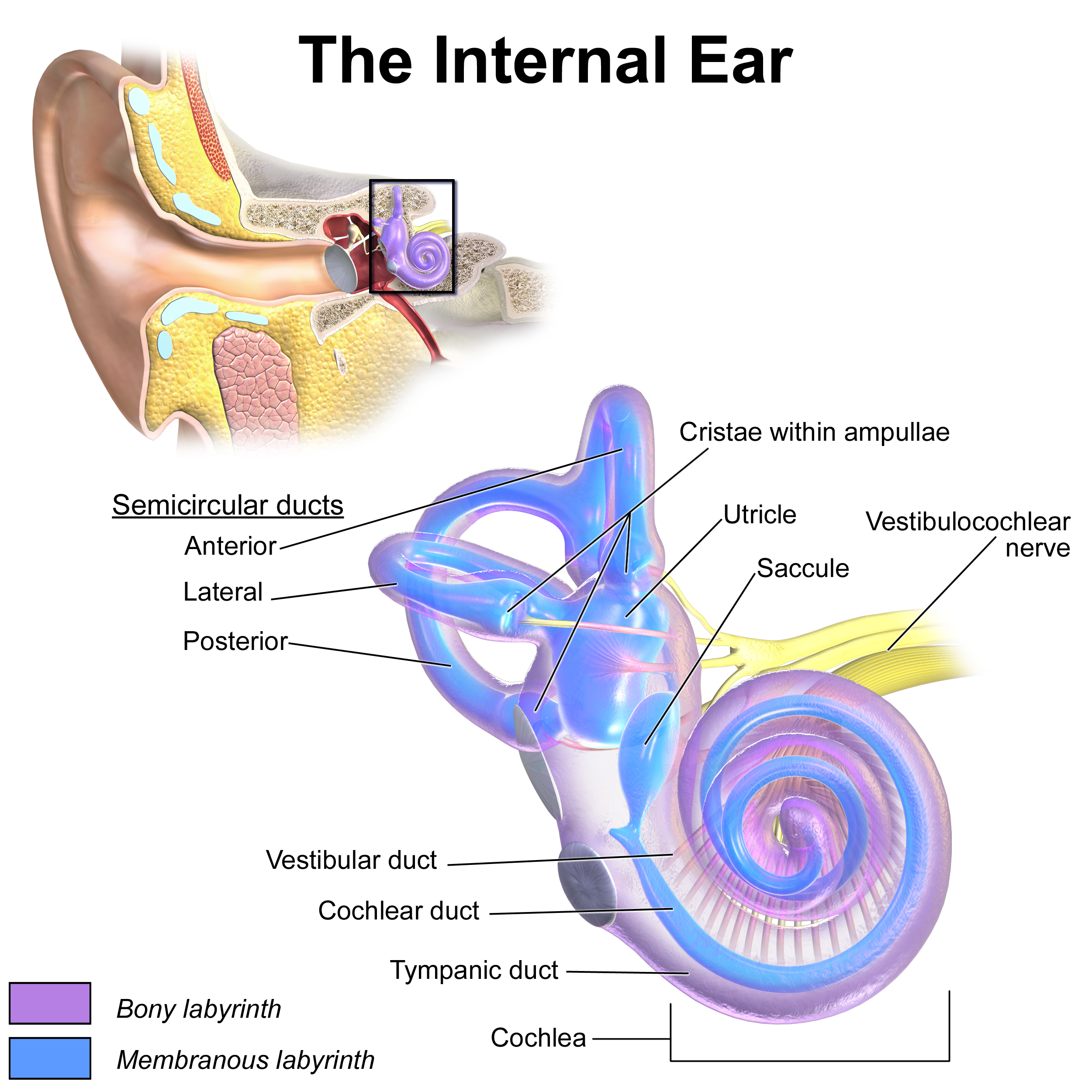
How do otolithic organs work?
Calcium carbonate crystals attached to hair cells are pulled by gravity when we shift our head, causing a synapse to be fired
What is somatosensation?
Collective term for body senses such as pressure, temperature, pain, and position.
Which neurons provide information about the timing of a stimulus?
Non-adapting neuron: fire at constant rate
Slow adapting neuron: fire at beginning and then slows down
Fast adapting neuron: fires at beginning, stops, then fires at end
These three together provide information about timing throughout the duration of a stimulus
What is a dermatome?
Provides neurons information on the location of the stimulus on the skin.
What is Signal Detection Theory?
Framework for measuring decision-making under uncertainty by comparing hits, misses, false alarms, and rejections.
What is a hit, miss, false alarm, and correct rejection (signal detection)?
Hit: Correctly saying a signal is present when it truly is present.
Miss: Failing to say a signal is present when it is actually present.
False Alarm: Incorrectly saying a signal is present when it is not.
Correct Rejection: Correctly identifying that no signal is present when it is indeed absent.
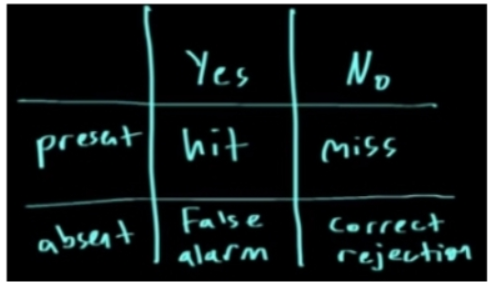
What is a conservative strategy?
Decision rule favoring ‘no’ responses unless absolutely certain, reducing false alarms but increasing misses.
What is a liberal strategy?
Decision rule favoring ‘yes’ responses, reducing misses but increasing false alarms.
What are Gestalt Principles?
Rules describing how the brain organizes visual information into meaningful wholes.
What is the Gestalt Law of similarity?
Gestalt rule that similar items are grouped together.
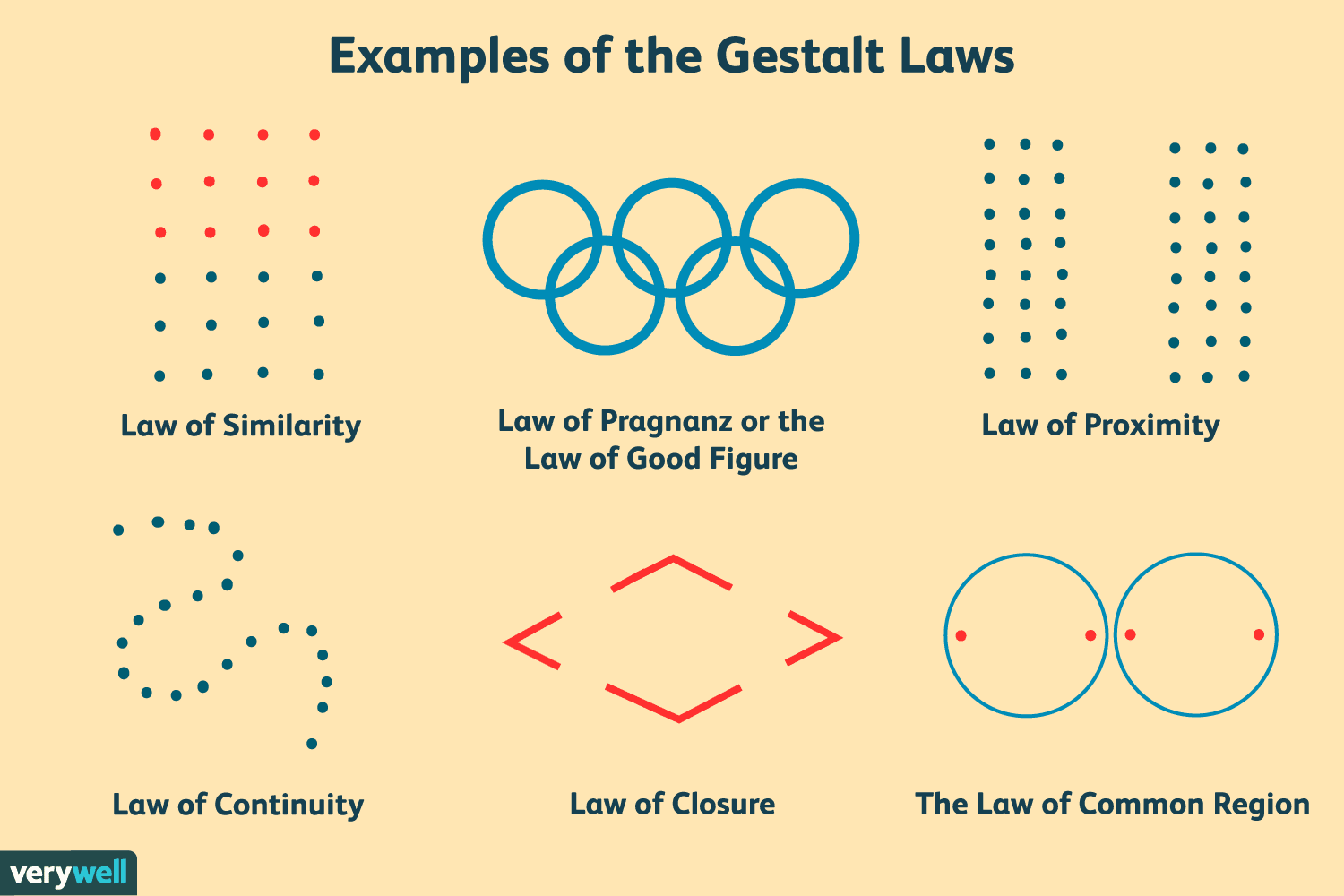
What is the Gestalt Law of pragnanz?
Tendency to perceive complex images in the simplest form possible (ex. Olympic rings are circles)
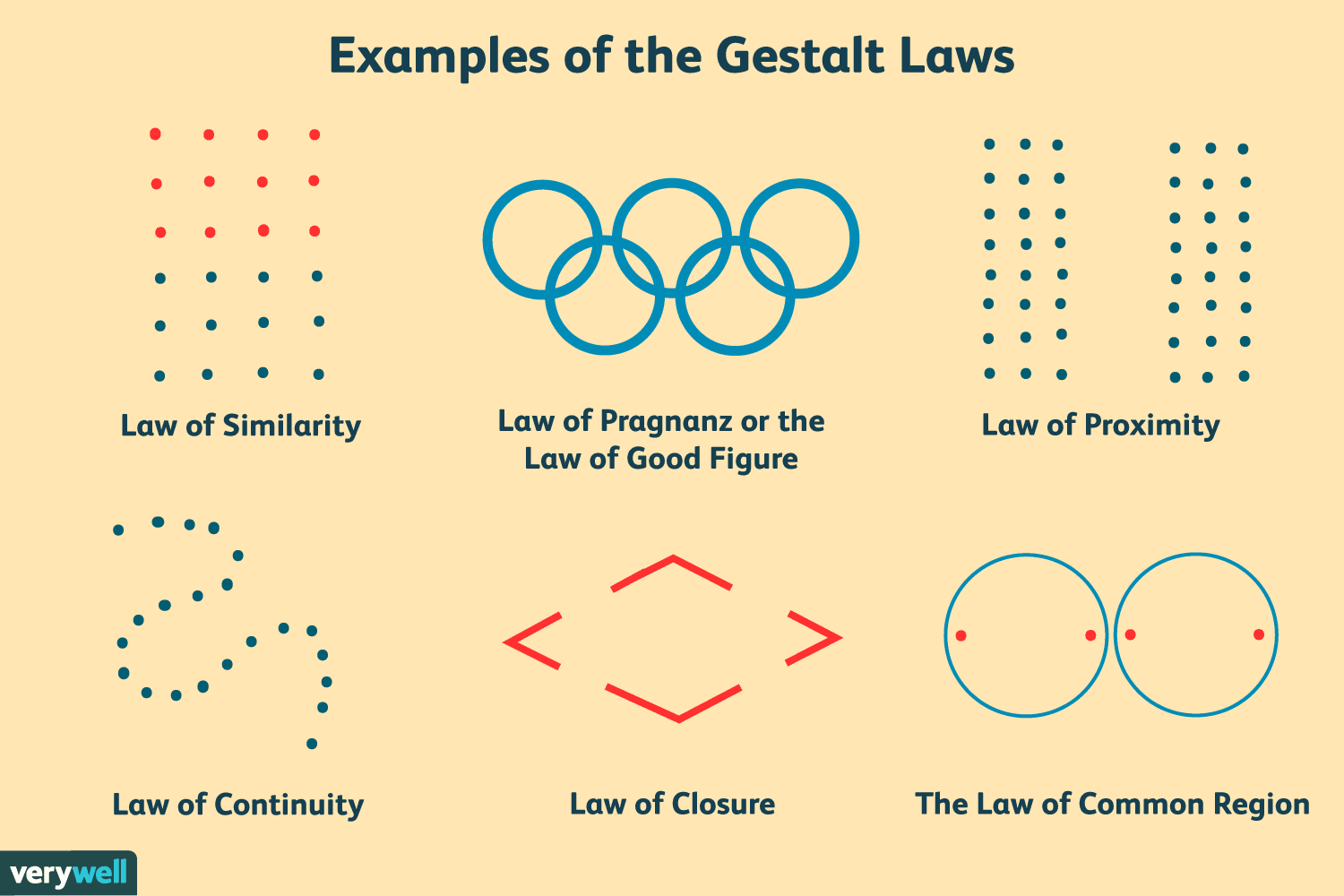
What is the Gestalt Law of proximity?
Stimuli close together are perceived as a group.
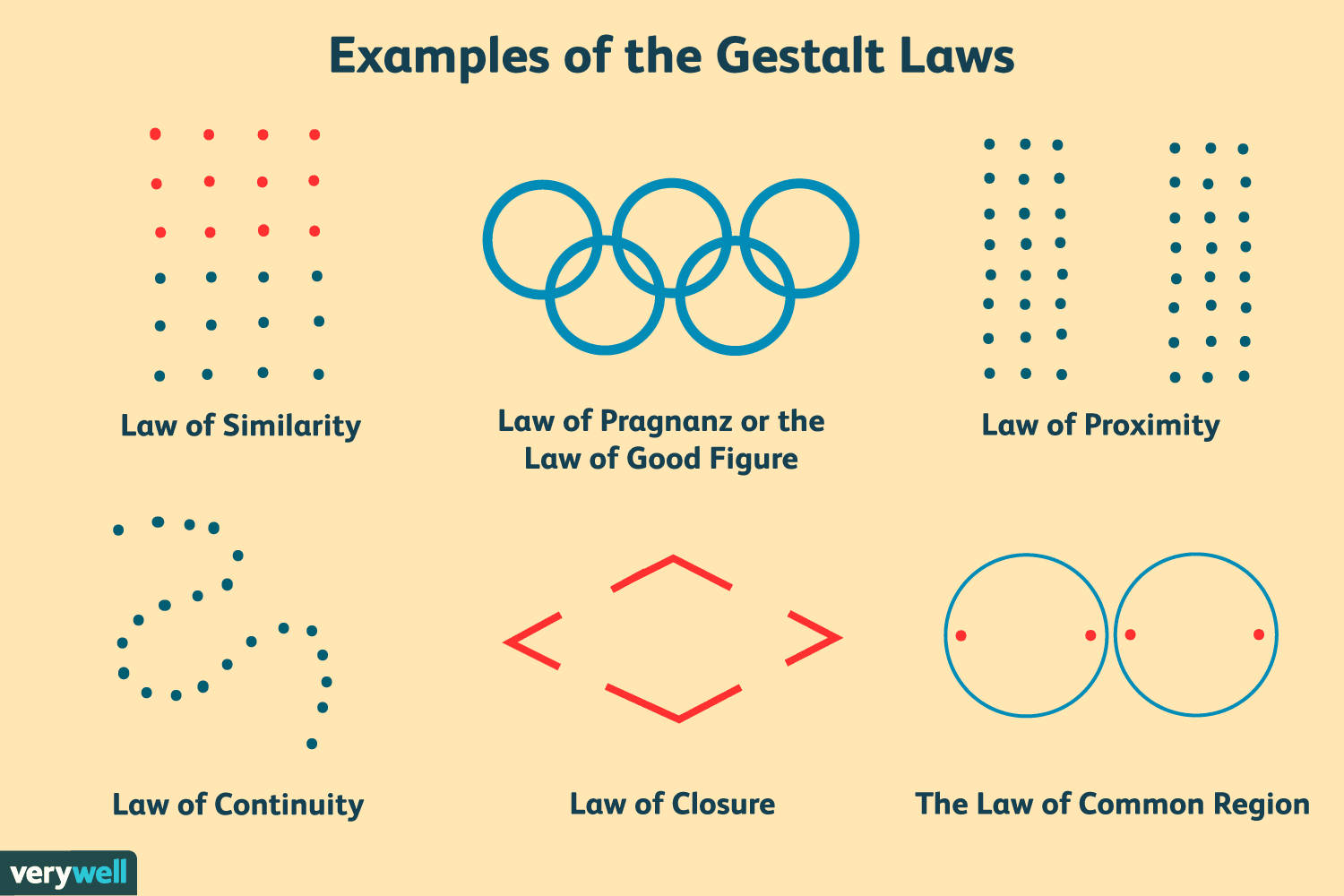
What is the Gestalt Law of continuity?
Elements arranged in a line or curve are seen as related.
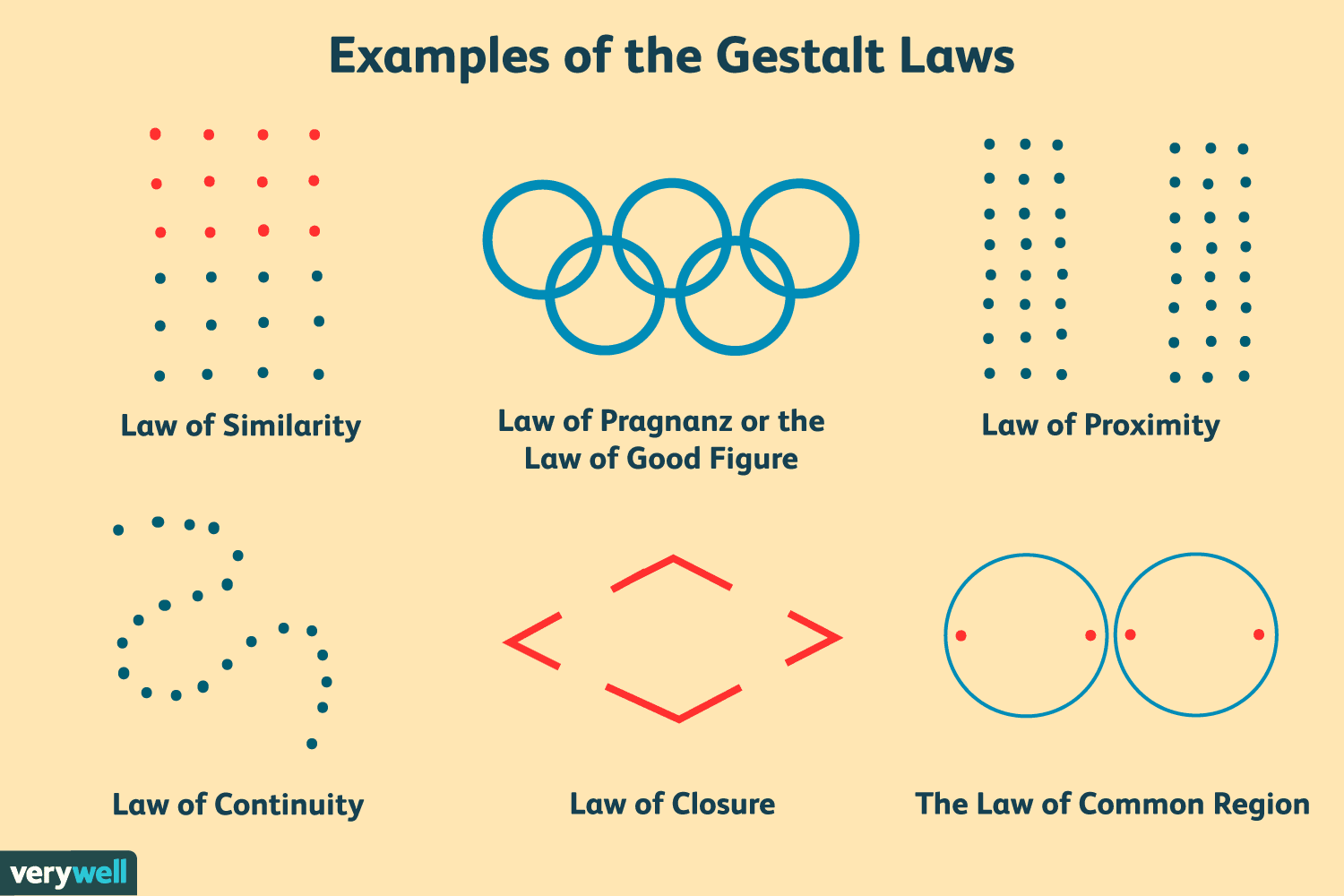
What is the Gestalt Law of closure?
Mind fills in gaps to perceive complete, enclosed forms.
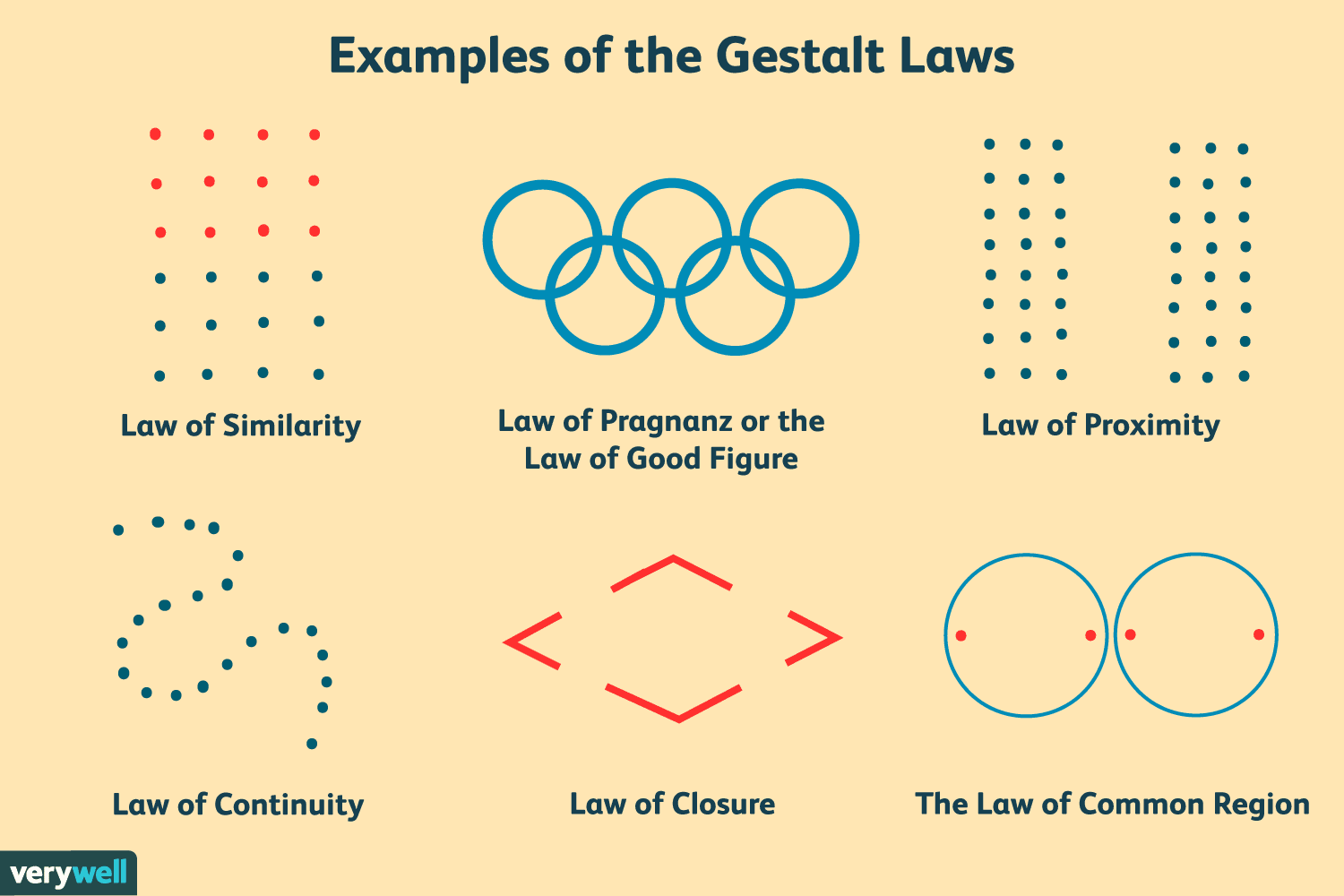
What is bottom-up processing?
Data-driven perception starting with sensory input and building up to meaning (you have no idea what to expect from the stimulus).
What is top-down processing?
Perception driven by prior knowledge, expectations, or context (you’re looking for a specific stimulus based on what you already know).
What are photoreceptors?
Convert light to neural impulses
What is a rod?
Photoreceptor sensitive to low light, not color, abundant at retinal periphery.
What is a cone?
Color-sensitive photoreceptor concentrated in the fovea, active in bright light.
What is the fovea?
Retinal region with highest cone density and maximal visual acuity.
What is the macula?
Central retinal area surrounding the fovea, rich in cones.
What is the phototransduction cascade?
Biochemical process by which light turns photoreceptors off, initiating visual signal.
Light hits rod → rod turns off → turns bipolar cell on → turns retinal ganglion cell on → optic nerve picks up signal → sent to brain
What is rhodopsin vs photopsin?
Rhodopsin is found in rods for low-light vision, while photopsin is found in cones for color vision under bright light. Both trigger the phototransduction cascade when exposed to light.
Which photoreceptor is most sensitive to light?
Rods → more sensitive and more numerous than cones
What is the optic chiasm?
X-shaped structure where nasal retinal fibers cross to the opposite brain side.
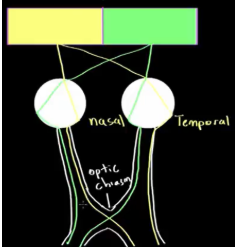
What is the parvocellular pathway?
Visual pathway specialized for color and fine form with low temporal resolution (can’t detect objects in motion).
What is the magnocellular pathway?
Visual pathway specialized for motion detection with high temporal resolution (motion observation) and no color.
What is parallel processing?
Brain’s ability to analyze color, form, and motion simultaneously.
What is the oval window?
Membrane between middle and inner ear that transfers vibrations to cochlear fluid.
What is the round window?
Membrane relieving pressure in cochlea by bulging opposite the oval window.
What is the cochlea?
Spiral inner-ear organ where mechanical sound is converted to neural impulses.
What is the organ of Corti?
Sensory structure atop the basilar membrane of the cochlea containing hair cells for hearing.
What is perilymph?
Fluid that moves inside cochlea when the oval window vibrates, deflecting hair cells.
What is basilar tuning?
Hair cells start at base of the cochlea and are found to the apex (deep inside)
Base → sensitive to high frequencies
Apex → sensitive to low frequencies
Sound enters cochlea → perilymph travels until it reaches the hair cell that matches the sound frequency → mapped to brain
What is the primary auditory cortex?
Brain area in temporal lobe that processes basic sound information by frequency.
What is sensory amplification?
up regulation → detection of stimulus results in signal that excites multiple other nerves that excite more and more until it reaches the brain
What is the somatosensory cortex?
Parietal-lobe region that maps bodily touch and position sensations. Specific body parts have specific and different places on the cortex.
What is kinesthesia? What is proprioception?
Kinesthesia: Sense of voluntary body movement, distinct from position sense
Proprioception: Sense of body position and movement.
What is the olfactory epithelium?
Specialized nasal tissue containing odorant receptor neurons. Scents come in and can bind to sensory cells that are specific to a particular scent.
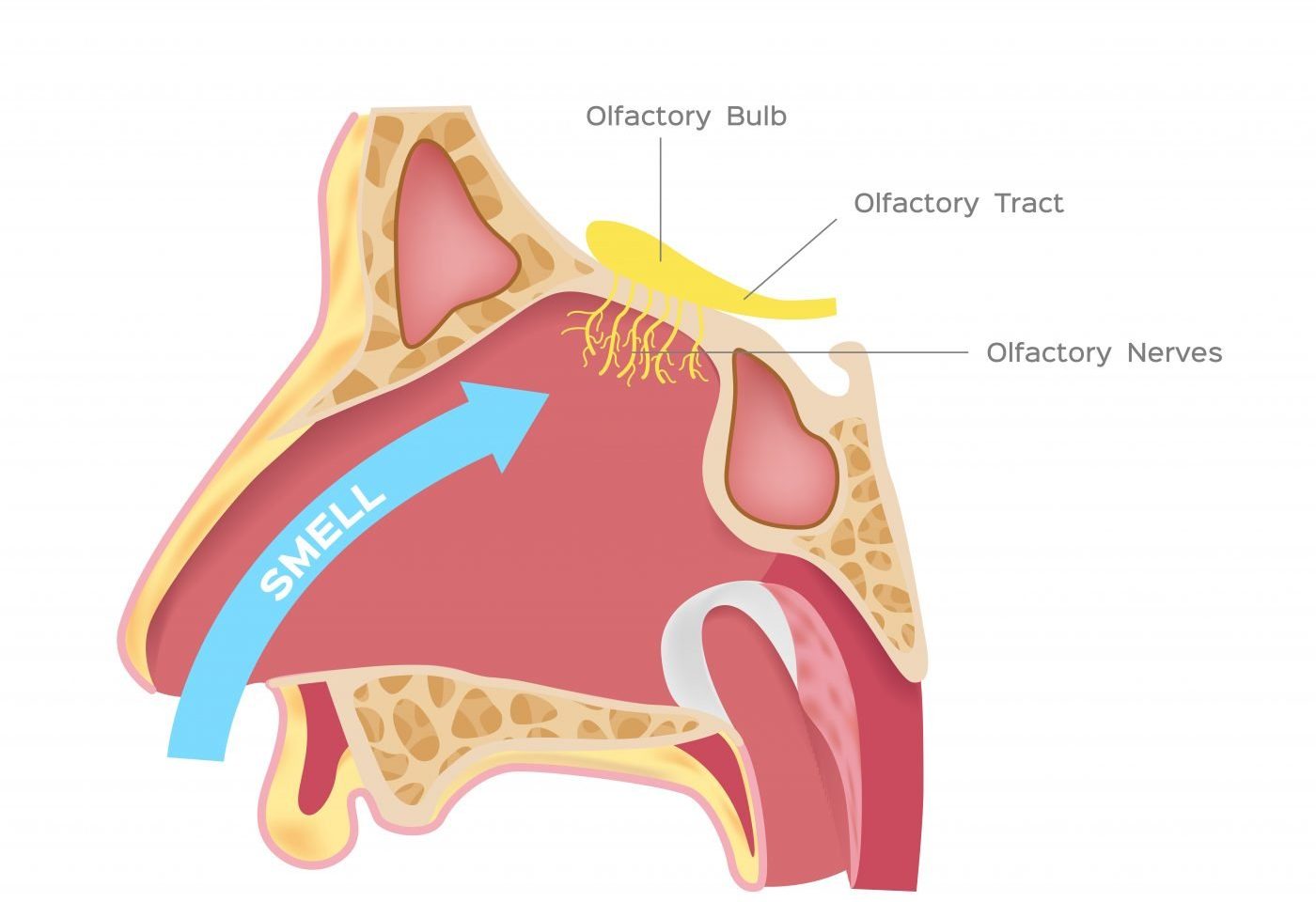
What is the cribriform plate?
Porous ethmoid bone through which olfactory axons reach the brain.
What is an olfactory glomerulus?
Cluster of synapses where olfactory receptor neurons expressing the same receptor converge.
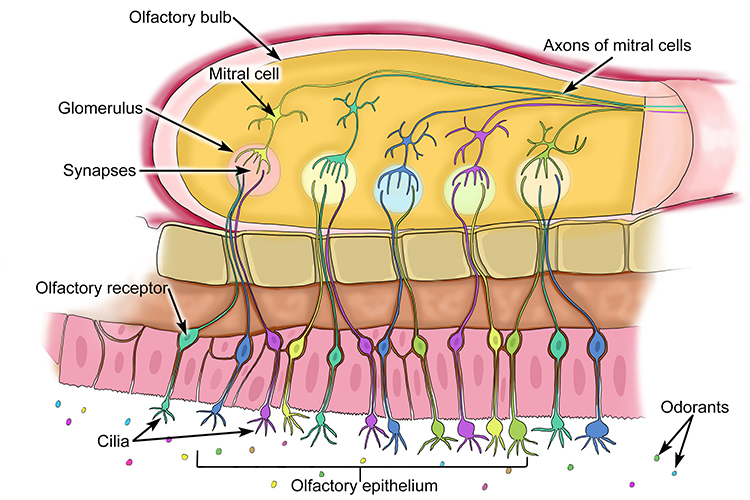
What is a mitral cell?
Second-order olfactory neuron that relays information from glomeruli to the cortex.
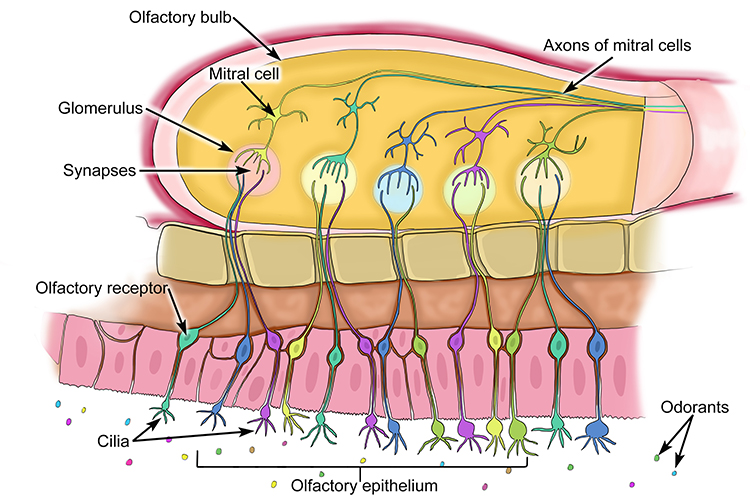
Describe the pathway of olfactory information starting from the scent molecule to the brain. Include olfactory receptors, glomerulus, olfactory bulb, mitral cells
Molecule → receptor + GPCR → glomerulus for that specific molecule within olfactory bulb → mitral cell → brain
Receptors and glomeruli are specific to one type of molecule (eg benzenes)
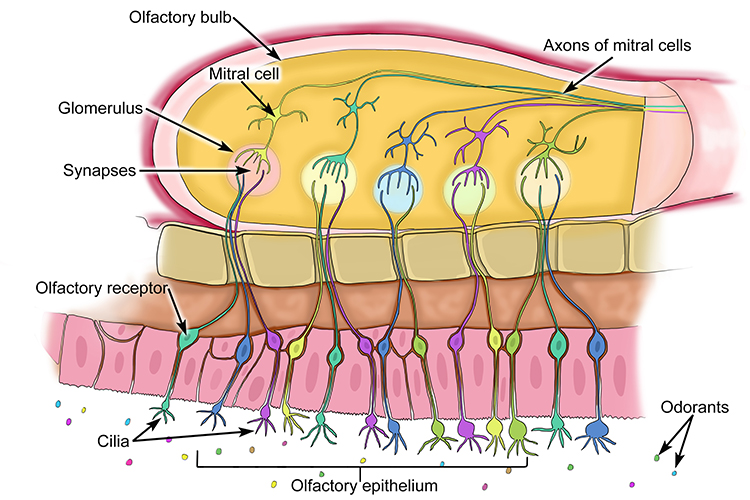
What is gustation?
Sense of taste detected by taste buds on tongue and palate.
What is a taste bud?
Cluster of gustatory receptor cells within papillae that transduce chemical tastants.
Does taste perception depend on the receptor or the cell with the receptor?
If salt binds to a salty receptor artificially placed on a sweet cell, the brain will interpret the flavor as sweet because of the cell type
Compare the four main brainwaves: alpha, beta, delta , theta
Beta: awake → highest frequency (can lead to stress)
Alpha: daydreaming → next lowest frequency → disappear in drowsiness but reappear in deep sleep
Theta: drowsiness → lower frequency for light sleep
delta : deep sleep or coma → slowest frequency
What happens during the N1 non REM sleep stage?
theta waves
Hypnagonic hallucinations: see/hear things that aren’t there
Hypnic jerks
What happens during the N2 non REM sleep stage?
N2: theta waves
Sleep spindles: rapid burst of brain activity
K complexes: suppress arousal for sleep; also memory maybe
What happens during the N3 non REM sleep stage?
δ waves
Walking, sleep talking, memory consolidation
What is REM sleep?
A stage of sleep characterized by rapid eye movements, increased brain activity, vivid dreams, and temporary muscle paralysis. Dominated by alpha and beta waves.
What is latent content vs manifest content of dreams?
Latent content refers to the hidden, symbolic meaning of dreams, as opposed to the manifest content, which is the literal storyline. It often reflects unconscious desires and thoughts.
What is the activation synthesis hypothesis?
Theory that dreams reflect the brain’s attempt to make sense of random brainstem activity.
What is Freud’s theory of dreams?
dreams have meaning to help us resolve hidden conflict
What is narcolepsy?
Sleep disorder marked by uncontrollable REM-sleep attacks during wakefulness.
What is sleep apnea?
Repeated cessation of breathing during sleep leading to daytime fatigue. Prevents N3 sleep
What is a depressant? What are effects and examples?
Drug class that decreases CNS activity, heart rate, and blood pressure.
Slows processing speed
Examples: alcohol, benzodiazepines, barbiturates
What is a stimulant? What are effects and examples?
Drug that increases CNS activity, heart rate, BP, and alertness.
Examples: cocaine, nicotine, caffeine, methamphetamine
What is a hallucinogen? What are effects and examples?
Substance that distorts perception and may cause sensory hallucinations.
Examples: LSD, shrooms
What is an opiate? What are effects and examples?
Analgesic drug acting on endorphin receptors, also called opioid. Depress CNS, HR, and BP. Act as analgesics.
Examples: morphine, codeine, heroin.
What is a GABA receptor?
Primary inhibitory neurotransmitter receptor in the brain influenced by many depressants.
What is drug tolerance?
The brain will prepare the body more and more each time in anticipation of drug intake → will bring the body lower so that more drugs are needed for same high
What is drug withdrawal?
Physiological and psychological symptoms occurring when drug use stops.
How does taking a drug outside of a normal routine impact the body differently from taking it in a routine?
With routine → body has time to adjust prior to drug intake
Out of routine → body doesn’t adjust yet → can lead to OD
How are the amygdala, nucleus accumbens, prefrontal cortex, and hippocampus involved in the reward pathway? Give examples in relation to eating cake.
Amygdala: controls emotions
I.e. produces the emotion of happiness when eating the cake
Nucleus accumbens: controls motor function
I.e. goes to take another bite
Hippocampus: memory formation
I.e. remembers the environment and experience of eating the cake
prefrontal cortex: focus, attention, planning
I.e. focuses attention on the cake
How does increased dopamine affect serotonin levels?
More dopamine → less serotonin
Serotonin is involved in satiation → serotonin decreases, you’re less likely to be content
What is Cognitive Behavioral Therapy (CBT)?
Psychotherapy that changes maladaptive thoughts and behaviors.
What is motivational interviewing?
Client-centered counseling to elicit and strengthen personal motivation for change.
What is divided attention?
Ability to split focus between multiple tasks, often decreasing performance (you end up switching between tasks instead of doing them simultaneously)
What is selective attention?
Focusing on one stimulus while filtering out others.
What is an exogenous cue?
External, attention-grabbing stimulus like a loud noise or bright color.
What is an endogenous cue?
Attention signal that requires internal knowledge, such as an arrow or one’s name.
What is inattentional blindness?
Failure to notice a visible stimulus because attention is directed elsewhere.
What is change blindness?
Failure to detect large changes in a visual scene.
What is the sensory register?
Initial, brief storage of incoming sensory information.
What is Broadbent's early selection model?
Attention model proposing filtering occurs before perceptual processing (assigning meaning).
What is Deutsch & Deutsch late selection theory?
Model stating all inputs are processed for meaning before selective filtering.
Basically all inputs are given meaning before deciding what you do or don’t need.
What is Treisman's attenuation theory?
Attention model where unattended input is weakened but still processed at lower strength.
If the attenuator assigns an important meaning to a previously weakened input, it will switch our attention and selectively focus on that instead
What is the spotlight model of attention?
Metaphor describing how we take info from 5 senses but don’t pay attention to everything
What is the resource model of attention?
Theory that attentional capacity is limited and tasks compete for resources.
How do task similarity, task difficulty, and practice affect the ease of multitasking?
Task similarity: if the tasks are too similar, multitasking is difficult (harder to separate the tasks)
Task difficulty: harder tasks require more focus
Practice: certain processes become automatic with practice → more brainspace for other tasks
What is the information processing model?
Cognitive framework comparing human thinking to computer operations: input—process—output.